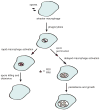Dueling in the lung: how Cryptococcus spores race the host for survival
- PMID: 20570552
- PMCID: PMC2920366
- DOI: 10.1016/j.mib.2010.05.003
Dueling in the lung: how Cryptococcus spores race the host for survival
Abstract
Many human fungal pathogens infect people when they are inhaled as spores. Despite the serious impact of fungal spores on human health, little is known about their basic properties or how they interact with the host. This is particularly true for Cryptococcus neoformans, a human fungal pathogen that causes more than 600,000 deaths annually. Spores of C. neoformans have not been well characterized previously because of technical challenges in isolating them; however, recent advances in spore isolation have lead to the first direct analyses of spores. Novel insights into the spore-host interaction, specifically how spores interact with alveolar macrophages, have provided a new model of cryptococcosis that could have broad implications for human fungal pathogenesis.
Copyright 2010 Elsevier Ltd. All rights reserved.
Figures


Comment in
-
Host-microbe interactions: fungi.Curr Opin Microbiol. 2010 Aug;13(4):389-91. doi: 10.1016/j.mib.2010.05.010. Epub 2010 Jun 16. Curr Opin Microbiol. 2010. PMID: 20558099 Free PMC article. No abstract available.
References
-
- Brown JK, Hovmoller MS. Aerial dispersal of pathogens on the global and continental scales and its impact on plant disease. Science. 2002;297:537–541. - PubMed
-
- Yoder JS, Beach MJ. Cryptosporidium surveillance and risk factors in the United States. Exp Parasitol. 124:31–39. - PubMed
-
- Driks A. The Bacillus anthracis spore. Mol Aspects Med. 2009;30:368–373. - PubMed
Publication types
MeSH terms
Grants and funding
LinkOut - more resources
Full Text Sources

